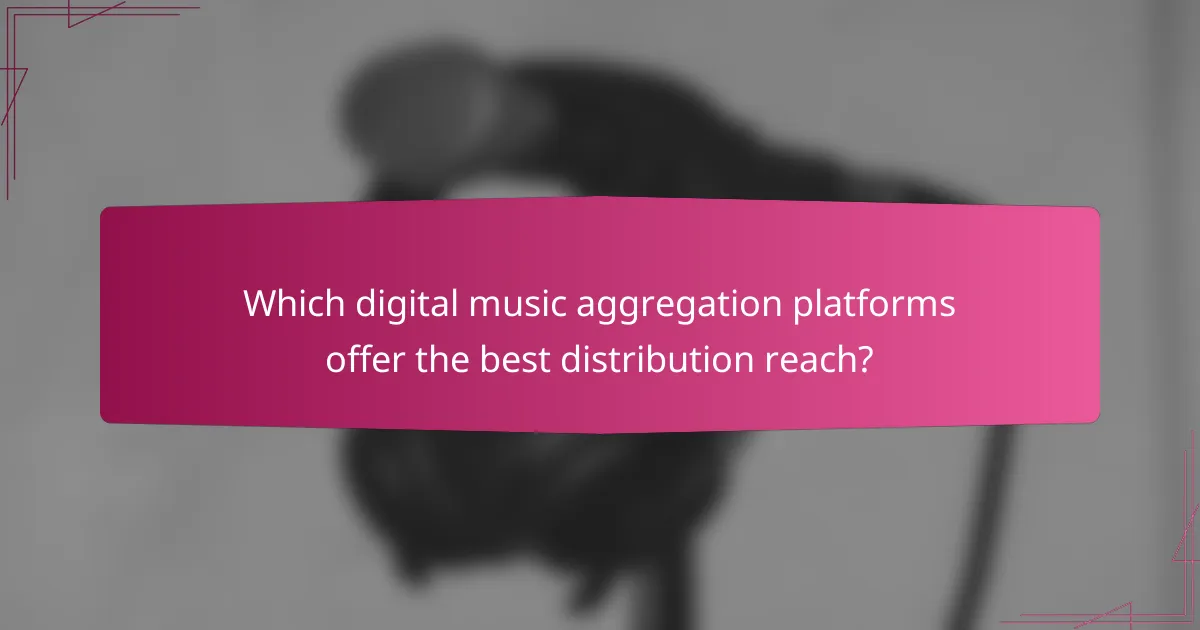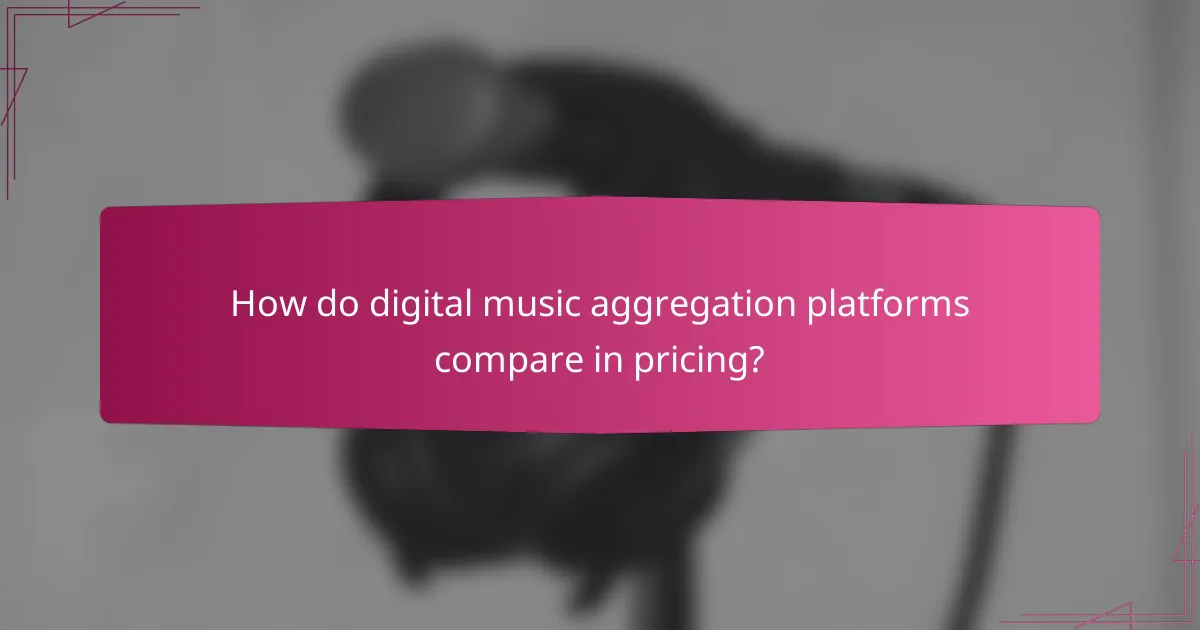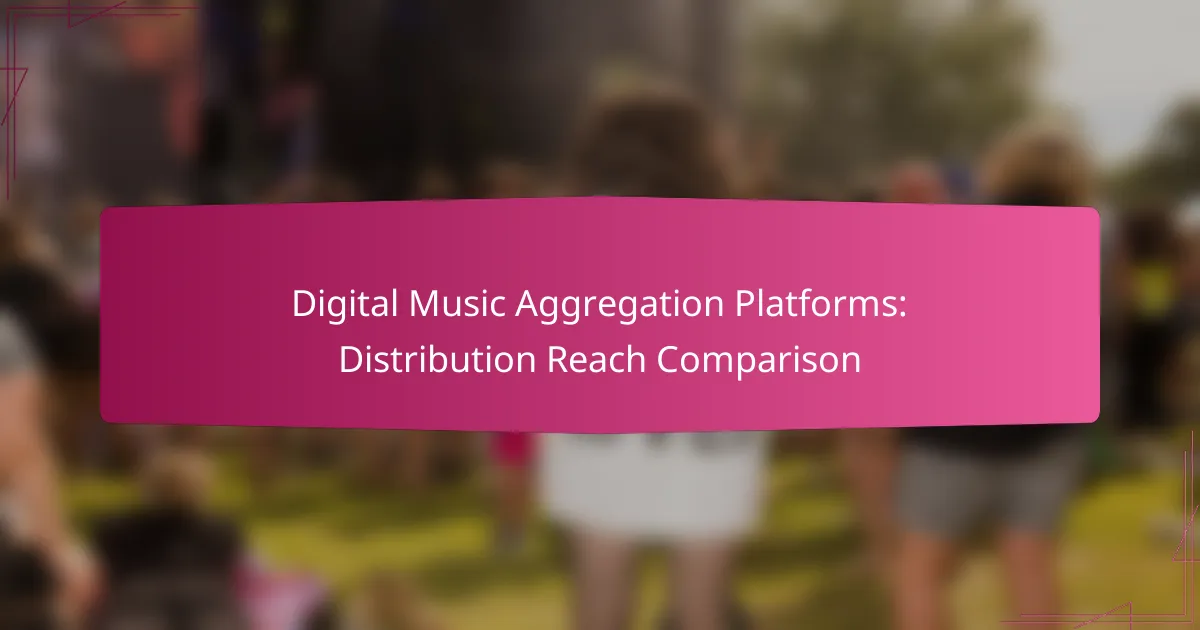Digital music aggregation platforms play a vital role in connecting artists with major streaming services, facilitating the distribution of their music. With varying pricing structures and features, these platforms offer options that cater to different artist needs, including control over their music and revenue management. Understanding the distinctions among these services is essential for musicians seeking to maximize their reach and impact in the digital music landscape.

Which digital music aggregation platforms offer the best distribution reach?
Several digital music aggregation platforms provide extensive distribution reach, allowing artists to get their music on major streaming services. The best choice depends on factors like pricing, speed, and the level of control desired by the artist.
CD Baby: Global distribution to major platforms
CD Baby offers artists global distribution to a wide range of major platforms, including Spotify, Apple Music, and Amazon Music. With a one-time fee for each release, artists retain 100% of their royalties, making it a popular choice for independent musicians.
Additionally, CD Baby provides services such as sync licensing and physical distribution, which can enhance an artist’s visibility and revenue streams. Their user-friendly interface simplifies the distribution process, making it accessible for newcomers.
TuneCore: Extensive reach with competitive pricing
TuneCore is known for its extensive reach, distributing music to over 150 digital stores worldwide. Artists can choose between annual fees or a pay-per-release model, allowing flexibility based on their release strategy.
With TuneCore, artists keep 100% of their sales revenue, which is appealing for those looking to maximize earnings. They also offer additional services like publishing administration, which can help artists collect royalties from various sources.
DistroKid: Unlimited distribution with fast delivery
DistroKid stands out for its unlimited distribution model, allowing artists to release as much music as they want for a single annual fee. This approach is particularly beneficial for prolific artists who frequently release new material.
Delivery is typically fast, with music appearing on platforms within a few days. DistroKid also offers features like automatic revenue splits for collaborations, making it easier for artists to manage joint projects.
AWAL: Selective distribution for independent artists
AWAL provides selective distribution, focusing on independent artists who meet certain criteria. This platform offers personalized support and marketing resources, which can be advantageous for artists looking to grow their careers.
While AWAL does not charge upfront fees, they take a percentage of the royalties, which can be a trade-off for the additional services provided. This model is ideal for artists who want a more tailored approach to distribution and support.

How do digital music aggregation platforms compare in pricing?
Digital music aggregation platforms vary significantly in their pricing structures, which can impact how artists distribute their music. Understanding these differences is crucial for musicians to choose the right service based on their needs and budget.
CD Baby: One-time fee per release
CD Baby operates on a one-time fee model, charging artists a set amount for each release. This fee typically ranges from around $9 to $49, depending on the type of release, such as singles or albums. Once paid, artists keep 100% of their royalties, making it a straightforward option for those who prefer a pay-per-release approach.
However, artists should consider that while there are no annual fees, they may incur additional costs for services like physical distribution or promotional tools. It’s essential to evaluate these extras when budgeting for a release.
TuneCore: Annual subscription model
TuneCore uses an annual subscription model, charging artists a fee each year to keep their music available on streaming platforms. The fees can start at approximately $14.99 for a single and around $29.99 for an album, with annual renewal costs. This model allows artists to maintain their music’s presence but requires ongoing investment.
Artists should weigh the benefits of continuous distribution against the recurring costs. If an artist plans to release multiple albums or singles, this model can become more economical over time, especially if they regularly generate income from their music.
DistroKid: Flat annual fee for unlimited uploads
DistroKid offers a unique pricing structure with a flat annual fee that allows for unlimited uploads. Starting at about $19.99 per year, artists can release as much music as they want without incurring additional charges per release. This model is particularly appealing for prolific artists who frequently release new content.
While DistroKid takes a percentage of the earnings, the unlimited uploads can lead to significant savings for artists who plan to distribute a large volume of music. It’s advisable to consider how often you release music and whether the flat fee aligns with your distribution strategy.

What are the key features of popular digital music aggregation platforms?
Digital music aggregation platforms serve as intermediaries between artists and music distribution channels, enabling musicians to release their music on various streaming services. Key features often include physical distribution, publishing administration, and revenue management tools tailored to the needs of independent artists.
CD Baby: Physical distribution and sync licensing
CD Baby offers artists the ability to distribute physical copies of their music, such as CDs and vinyl, alongside digital releases. This feature is particularly beneficial for musicians looking to sell merchandise at live shows or through their websites.
Additionally, CD Baby provides sync licensing services, allowing artists to license their music for use in film, television, and advertisements. This can open up new revenue streams, as sync deals often pay significantly more than standard streaming royalties.
TuneCore: Publishing administration services
TuneCore specializes in publishing administration, helping artists manage their songwriting royalties and ensuring they receive payments from various sources. This includes collecting performance royalties from organizations like ASCAP and BMI, which can be a complex process for independent musicians.
By using TuneCore, artists can retain full ownership of their music while benefiting from comprehensive tracking and reporting tools. This transparency helps musicians understand where their income is coming from and how to maximize their earnings.
DistroKid: Automatic revenue splitting for collaborations
DistroKid stands out for its automatic revenue splitting feature, which simplifies the process for artists collaborating on projects. When multiple musicians contribute to a track, DistroKid can automatically distribute earnings based on pre-set percentages, reducing the administrative burden.
This platform is particularly advantageous for independent artists who frequently collaborate, as it ensures that all parties are compensated fairly and promptly. DistroKid’s user-friendly interface and quick setup make it a popular choice for those looking to streamline their distribution process.

What are the benefits of using a digital music aggregation platform?
Digital music aggregation platforms offer artists a streamlined way to distribute their music across various streaming services, enhancing their reach and visibility. By using these platforms, musicians can access global markets, track their performance, and ultimately grow their audience.
Increased visibility on streaming services
Using a digital music aggregation platform significantly boosts an artist’s visibility on popular streaming services like Spotify, Apple Music, and Amazon Music. These platforms often have established relationships with these services, ensuring that new releases are prominently featured and easily discoverable.
For instance, many aggregators provide playlist placement opportunities, which can lead to increased streams and followers. Artists should consider platforms that offer promotional tools to maximize their exposure.
Access to global markets and audiences
Digital music aggregation platforms enable artists to distribute their music internationally, reaching audiences across different countries and cultures. This global access can lead to diverse fan bases and increased revenue opportunities from various markets.
Artists should look for aggregators that support multiple currencies and local payment methods, making it easier for fans worldwide to purchase or stream their music. This can enhance an artist’s income potential significantly.
Analytics and reporting for performance tracking
Most digital music aggregation platforms provide detailed analytics and reporting tools that allow artists to track their performance across different streaming services. This data can include information on streams, downloads, and listener demographics, helping artists understand their audience better.
By analyzing this data, musicians can make informed decisions about marketing strategies and future releases. It’s crucial for artists to regularly review these analytics to identify trends and optimize their promotional efforts effectively.

What criteria should artists consider when choosing a digital music aggregator?
Artists should consider distribution reach, pricing structures, and additional services when selecting a digital music aggregator. These factors directly impact how effectively their music reaches audiences and how much they will earn from their releases.
Distribution reach and platform partnerships
Distribution reach refers to the number of platforms where an artist’s music will be available. Popular aggregators often partner with major streaming services like Spotify, Apple Music, and Amazon Music, which can significantly increase visibility. Artists should verify which platforms are included in the aggregator’s distribution network to ensure their music is accessible to their target audience.
Additionally, some aggregators may offer exclusive partnerships with certain platforms, which can provide unique promotional opportunities. Understanding the extent of an aggregator’s reach can help artists maximize their exposure and potential revenue.
Pricing structure and hidden fees
Pricing structures among digital music aggregators can vary widely, with some charging a flat fee per release while others take a percentage of earnings. Artists should carefully review the pricing model to determine which option aligns with their financial goals. It’s essential to account for any hidden fees that may arise, such as annual renewal fees or costs for additional services.
For example, some aggregators may advertise low upfront costs but charge higher percentages on royalties. Artists should calculate potential earnings based on different scenarios to ensure they choose the most cost-effective option.
Additional services like marketing and promotion
Many digital music aggregators offer additional services that can enhance an artist’s visibility, such as marketing and promotional tools. These services may include playlist placements, social media marketing, or access to analytics that help artists understand their audience better. Artists should evaluate what extra services are available and how they can benefit their music career.
Some aggregators may provide tiered packages, where higher fees come with more extensive promotional support. Artists should weigh the potential return on investment for these services against their budget and marketing needs to make an informed decision.
